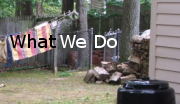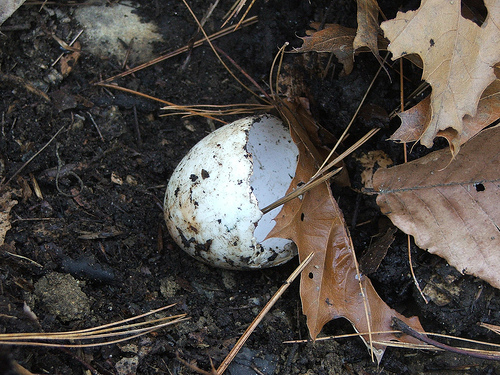Do you think about the future? Do you wonder what it will be like? Or do you live like it’s always going to be the way it has been?
~
I found at least 5 entries like this one, all in drafts, abandoned. As I prepare for the growing season with more resolve and urgency than ever before now that my apprenticeship is over (ha!), I need to line up my motivations like a general does her troops. This is just a declaration, not a proof or demonstration: others are supplying the data much more clearly and comprehensively than I ever could.
~
1. We’ve got problems
I believe that sometime in my lifetime, and certainly in the lifetime of my daughter, life will be changed, drastically. This is because three changes are already happening.
- Peak Oil
(I believe that) there will be a chronic shortage in oil production and thus cheap oil. This year, in 20 years, I don’t know, but in my lifetime. This will not just affect the heating of our houses and our trips to the grocery store, but also the delivery trucks’ trips to the grocery store, and the farm equipment that “grows” our produce, and the factory equipment that put together all those plastic containers for our shampoos, and the pharmaceuticals producing our medicine, etc. (cf. The Oil Drum)
- Economic Depression
(I believe that) increasing debt, decreasing value of money, hyperinflation, the precariousness of globalization and the lie of never-ending growth will soon mean the end of any value to our national currency, the end of imports, the closing of businesses and banks, rampant unemployment, the end of the middle class as we know it, and the cessation of public services. (cf. The Crash Course)
- Climate Change and Overpopulation
(I believe that) the Earth is changing and that it’s too late to do anything about it (if we ever could), that several tipping points have been already been (b)reached. The effect is the disturbance of the climate pattern upon which our agriculture and settlements developed and rely, and thus a growing difficulty for growing food and maintaining our towns and cities. This means a growing number of climate refugees and massive immigrations of our immense world population.
All three are interrelated. I suspect Economic Depression will be the first step, soon exacerbated by Peak Oil, then, more gradually but much more insistently, Climate Change. (Read also, John Michael Greer’s “Endgame” and Richard Heinberg’s Museletter).
~
2. Collapse
I believe that even just one and certainly all of these events together will lead to collapse. I don’t believe it will be as bad as zombies or The Road, but I foresee some hard times and, at the very least, the end of the way we live our lives today.
I can’t say that it is my hope that this won’t happen. Don’t get me wrong, it would be great if it didn’t. If, for instance, we found some renewable, clean and omnipresent source of energy, freely and democratically available, capable of powering our fleet of vehicles and our agricultural and factory equipment. Oh, and if it could also reverse the climate change tipping points… Sounds like heaven on earth to me, but I’ll just go ahead and prepare for if that doesn’t happen.
And it’s not like we have a lot of time. Collapse is already happening. Maybe not to me, or you, but to many in this country, in the world, and to whole countries even, to some degree or another. But for reasons that will become clear, here I just want to talk about myself, my family, and my neighborhood.
~
3. Hope
Still, I have hope. I hope that (for myself and my community, at least), collapse will be gradual enough. I hope it’s not a precipice, but a staircase, and that at each step enough people will (have to) take sufficient action to “catch up” on the decline. I hope that we can descend gracefully: without famine, violence, the destruction of culture and civilization…
A funny thing, though, this hope. I hope it’s reasonable (unlike “aw, come on, nothing‘s going to happen!”). It will require hard work and sacrifices, but we could pull it off. And to those who say “forget it, it’s too late, TS is really going to HTF,” I say “I hear you, but you know what? I have no choice but to hope. My child leaves me no choice.” I must do my best to make my hope, her hope come true.
~
4. Starting descent
How do I do this? We, myself and my immediate family, have already started to power down. For instance, this month, February 2010, is our 16th month of the Riot for Austerity. In the Riot we try to decrease our consumption of oil, water, electricity, and consumer goods, and our production of waste, all to10% of the US national average. It’s tough! We’re almost there with certain things, but not anywhere near 10% with others.
We changed our eating habits: less meat, less food, more bulk, dry goods, and very little eating out. We are establishing a large food garden, with a hoop house for a winter harvest, and hopefully a beehive soon, and chickens. We work on our food storage and emergency supplies. The immediate goal is to grow and store enough and a healthy variety of food to feed two families, and to plant an extra row for the hungry. You can find more details of our lifestyle changes on the “What We Do” page.
Why are we doing this, making these sacrifices in the time and the land that is still plenty? Do IÂ think it’s going to make a difference to climate change? I’m not that naive.
- But I do it out of principle: to take more than what one needs is to be greedy and bad for the soul.
- I do it because, when I make something myself, with my own time and genius and effort, I take responsibility for it and I take care of it as a thing that I love. When I buy it, I just get the responsibility, like an extra price tag, easily snipped off. I “take care” of it only because it cost me so much – or, more frequently, I don’t take care of it at all, because it cost me so very little. I want to take control, responsibility, and care.
- I want to be prepared – practically and psychologically – for a future with less cheap oil, less income, less security, more manual labor, the need for different kinds of skills, etc.
- I do it to set up a model for others, for when circumstances will force them, too, to adopt such a lifestyle. That’s my next point.
~
5. A model
We take these and many other actions as an average (middle class) family, with an average income and debt. We can’t bring in the big machines to flatten the land and mow down all the trees that shade our vegetable garden. We can’t tear down our 1950’s ranch and put a zero energy house in its place. We can’t buy the $1000 compost toilet, the photovoltaics, the hybrid car. And that’s good, because that makes our place an attainable model for anyone in our quite average situation around here.
As people start realizing they can no longer afford the $300 electricity bill, the $4000 oil bill, or the cable subscription, we can show them that it’s possible both practically and psychologically, for them to descend without hurting and actually even gaining something. For we don’t need television and video games to entertain ourselves, and digging in the garden is better exercise than the gym, and eating from that garden is healthier than take-out. I hope to demonstrate by example that living with a little less at a time does not need to hurt.
~
6. Will that be all?
Do I think that what we are doing and working on – this 90% reduction in consumption of this and that, this 50% (?) self-reliance in food, this reskilling, etc. – will be all that is required of us?
Not by a long shot! But as a first step it’s the perfect preparation for the second step.
Which is? I don’t know. Ask me on a good day, then ask me again on a bad day. All I know is that what my family and I are doing right now is not what will be required, at some point, of all of us, and that after that, there will be even more.
Think of it. When oil hits $5, or $10, or $50 a gallon? When the shelves in the grocery store stay empty? When we are freezing in our houses? When half the people on the street are unemployed, and one third is homeless to boot? When a shift in climate wipes out a major crop? When the majority of us can no longer ignore or evade the situation, because our money can’t buy anything? Now we’re talking collapse.
There are times when I think the worst and that head-for-the-hills feeling flares up. When, in essence, I lose hope. But I squash it. Many reasons make it impossible for my family to pack up and dig in. It wouldn’t work for me to want to live as if collapse has already happened. It would wreck my family and isolate me. That’s not what I’m aiming for.
So if in the eyes of some I take it too fast, and in the eyes of others I take it too slow, so be it. I hope I’m hitting that golden mean, but I also know that mean is sliding down as we speak, until at some point “too much” and “too little” collapse into one.
In the meantime I hope the forerunners can be helpful, by their example, to the masses descending behind them. But if there’s suddenly going to be a whole lot of people barreling down that ever steeper and narrower staircase, it would be good for those who are ahead to install a railing as they go. Or else we’re all going to end up in a big, crushed heap at the bottom.
~
That railing is relocalization, but about that, next time. It takes a lot out of me to write this, and it takes a long time to write, because I know that most of you don’t agree, and I feel I have to be argumentative, on the defensive, and watch my words. While I just want to say it like it is for me, so we know where I stand.







